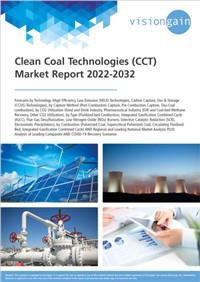The Clean Coal Technologies (CCT) Market Report 2022-2032: This report will prove invaluable to leading firms striving for new revenue pockets if they wish to better understand the industry and its underlying dynamics. It will be useful for companies that would like to expand into different industries or to expand their existing operations in a new region.
In the Fight Against Climate Change, Japan Promotes “Clean” Coal
By 2030, Japan’s government plans to phase out 90% of the country’s inefficient and old coal-fired power plants, while creating high-efficiency coal power plants. Japan’s Minister of Economy, Trade, and Industry (METI), Hiroshi Kajiyama, announced that coal-fired power will continue to be the country’s principal source of energy, but that 114 coal power units with high CO2 emissions will be shuttered to reduce overall carbon emissions. In Japan, there are approximately 140 coal-fired power plants. New coal power plants will be installed with efficient technology that attempt to use renewable energy as the major energy source as a first step toward building a carbon-neutral society. Kajiyama intends to expand renewable energy by revisiting power grid use guidelines. METI will convene a conference with specialists this month to identify tangible strategies to minimise CO2 emissions from inefficient coal power facilities. With the assistance of electricity suppliers, an upper limit on power generation will be imposed for inefficient power plants.
Challenge of Greenhouse Gases (GHGs) Emitted by Typical Coal-Fired Power Plants
Leaving aside all of the aforementioned advantages, there is a worldwide push to reduce coal usage for electricity generation. This is due to the high quantities of greenhouse gases (GHGs) emitted by typical coal-fired power plants, principally carbon dioxide (CO2), as well as pollutants such as nitrous oxide (NOX), sulphur dioxide (SO2), and particulates. Natural gas is the most practical fossil-fuel-based power generating alternative to coal, with fewer greenhouse gas emissions per kWh of energy generated. Natural gas, on the other hand, is more expensive, and it will not overtake coal as the primary source of fossil-fuel-based power generation in the next 20–30 years. Coal’s global dominance in energy generation is expected to last until 2040. As can be seen from this prediction, natural gas and renewable-based power generation will catch up to coal-based electricity generation in the early 2040s. As a result, alternate and cleaner methods of using coal for energy generation must be investigated.
What Questions Should You Ask Before Buying a Market Research Report?
- How is the clean coal technologies (CCT) market evolving?
- What is driving and restraining the clean coal technologies (CCT) market?
- How will each clean coal technologies (CCT) submarket segment grow over the forecast period and how much revenue will these submarkets account for in 2032?
- How will the market shares for each clean coal technologies (CCT) submarket develop from 2022 to 2032?
- What will be the main driver for the overall market from 2022 to 2032?
- Will leading clean coal technologies (CCT) markets broadly follow the macroeconomic dynamics, or will individual national markets outperform others?
- How will the market shares of the national markets change by 2032 and which geographical region will lead the market in 2032?
- Who are the leading players and what are their prospects over the forecast period?
- What are the clean coal technologies (CCT) projects for these leading companies?
- How will the industry evolve during the period between 2020 and 2032? What are the implications of clean coal technologies (CCT) projects taking place now and over the next 10 years?
- Is there a greater need for product commercialisation to further scale the clean coal technologies (CCT) market?
- Where is the clean coal technologies (CCT) market heading and how can you ensure you are at the forefront of the market?
- What are the best investment options for new product and service lines?
- What are the key prospects for moving companies into a new growth path and C-suite?
You need to discover how this will impact the clean coal technologies (CCT) market today, and over the next 10 years:
- Our 535-page report provides 344 tables and 333 charts/graphs exclusively to you.
- The report highlights key lucrative areas in the industry so you can target them – NOW.
- It contains in-depth analysis of global, regional and national sales and growth.
- It highlights for you the key successful trends, changes and revenue projections made by your competitors.
This report tells you TODAY how the clean coal technologies (CCT) market will develop in the next 10 years, and in-line with the variations in COVID-19 economic recession and bounce. This market is more critical now than at any point over the last 10 years.
The report delivers exclusive COVID-19 variations and economic data specific to your market.
Forecasts to 2032 and other analyses reveal commercial prospects
- In addition to revenue forecasting to 2032, our new study provides you with recent results, growth rates, and market shares.
- You will find original analysis, with business outlooks and developments.
- Discover qualitative analyses (including market dynamics, drivers, opportunities, restraints and challenges), cost structure, impact of rising clean coal technologies (CCT) prices and recent developments.
This report includes data analysis and invaluable insight into how COVID-19 will affect the industry and your company. Four COVID-19 recovery patterns and their impact, namely, “V”, “L”, “W” and “U” are discussed in this report.
Segments Covered in the Report
Technology
- High Efficiency Low Emission (HELE) Technologies
- Carbon Capture, Use & Storage (CCUS) Technologies
Capture Method
- Post-Combustion Capture
- Pre-Combustion Capture
- Oxy-Coal combustion
CO2 Utilization
- Food and Drink Industry
- Pharmaceutical Industry
- EOR and Coal-bed Methane Recovery
- Other CO2 Utilization
Type
- Fluidized-bed Combustion
- Integrated Gasification Combined Cycle (IGCC)
- Flue Gas Desulfurization
- Low Nitrogen Oxide (NOx) Burners
- Selective Catalytic Reduction (SCR)
- Electrostatic Precipitators
Combustion
- Pulverized Coal
- Supercritical Pulverized Coal
- Circulating Fluidized Bed
- Integrated Gasification Combined Cycle



